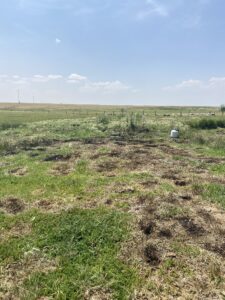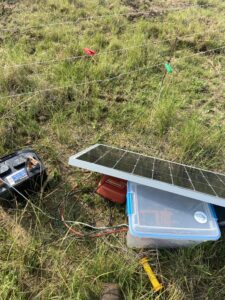Tanning Efficiency
#bfrdpwy #aginternship #RightRisk
This was the last week of my internship, and I am amazed by how much I have learned over the past ten weeks. My last week was slower than usual, but I was still able to learn a few things. I learned how to check if the tannins had thoroughly penetrated the hide. You do this by cutting a piece off the hide and if it has gone through the layer of the skin all the way, it is done. As you can see from the picture, this hide has not yet been fully penetrated. There is a new charger set up for the pigs and I learned how much easier it is to have a solar panel. The solar panel allows for the battery to last and not have to be recharged. The new controller shows how many volts are going through the poly wire, which will enable you to see if there are any issues. I burned some more of the foxtails this week and learned how fast manure can light on fire. I also learned it is essential to check the wind and humidity before doing a controlled burn.

This week, I reflected on the different tanning methods I have learned, specifically the bark tanning process versus the egg method. Both methods come with their own set of benefits and challenges. By questioning the effectiveness and practicality of these methods, I can determine the most suitable approach for my work. For example, eggs are more readily available to most people, whereas bark tanning requires a significant amount of bark. From my observations, egg tanning demands more effort but allows you to finish your hide much quicker than bark tanning, which requires a long soaking period. Most modern tanneries use chrome tanning because it is cheaper, but it involves harsh chemicals that can harm the environment and result in lower-quality leather. This process of critical thinking illustrates the importance of laying out all factors before deciding on the best approach to use. By challenging traditional methods and looking at new approaches, I can ensure that I am making thoughtful and sustainable choices.

I still have questions I would like to explore further. One area of concern from this week is preventing and treating flystrike for the livestock guardian dog. I want to understand the most effective treatment options, how to detect it early, and preventative measures to ensure the health of the working dogs. Additionally, I have questions about the effectiveness of different methods when removing foxtails. I would also want to understand the challenges and benefits of each method to see what would be the best for the situation on the pasture.

With all that I have learned this past week, I plan to use these strategies in the future. Tanning hides has led me to dive deeper into the different methods available. I believe this is important to carry through life as it emphasizes the value of researching various approaches. When I have livestock one day, I will ensure that I have a solar panel set up, as I have found this makes life a lot easier. Learning about controlled burns will help me to remove weeds safely in the future, ensuring that I consider factors such as wind and humidity to prevent fires. It is also essential to be aware and cautious of issues such as flystrike to ensure the health of working dogs. By applying these lessons, I strive to enhance efficiency, sustainability, and animal welfare in the future.
Submitted by: Elizabeth Herman
Edits by: GrowinG Internship Team

